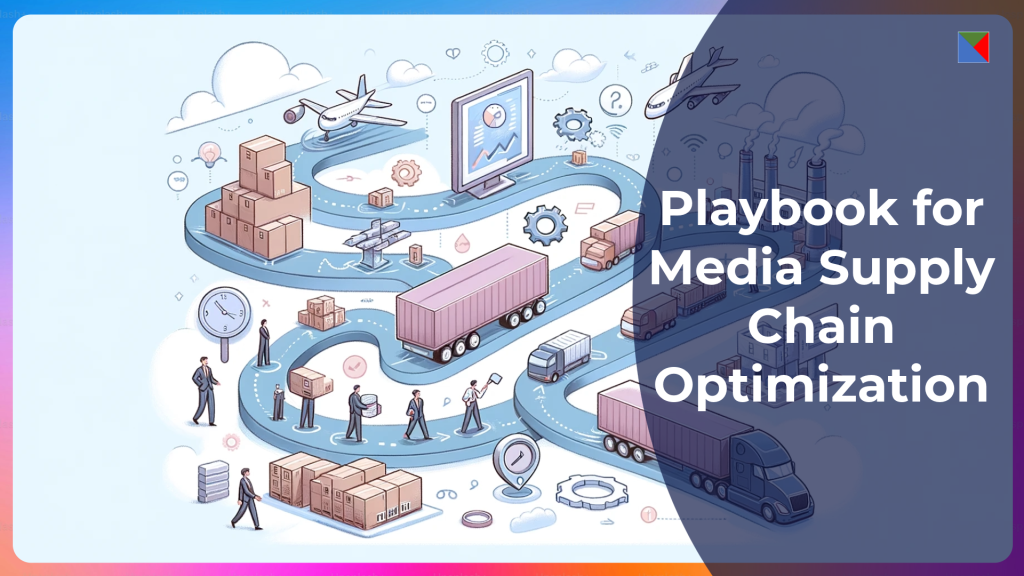
A Strategic Playbook for Media Supply Chain Optimization
The curtain rises on a familiar scene, yet one undergoing a dramatic transformation. Picture this: In 1995, a single blockbuster film generated revenue through a predictable sequence—theatrical release, home video sales, television licensing, and perhaps international distribution deals. The supply chain was linear, controlled, and finite. Fast-forward to today, and that same piece of content spawns infinite variations: director’s cuts for streaming platforms, short-form clips for social media, interactive experiences for gaming consoles, localized versions for dozens of markets, and personalized recommendations that fuel algorithmic engagement across countless touchpoints.
This exponential multiplication of content touchpoints represents both the industry’s greatest opportunity and its most perplexing challenge. Why do media companies, armed with unprecedented technological capabilities and global reach, struggle to extract maximum value from their content libraries? The answer lies hidden in plain sight, embedded within the very systems designed to expand their reach.
When More Becomes Less
For decades, the media and entertainment industry operated on a relatively predictable script: produce content, distribute it through established channels, and monetize via advertising or traditional subscriptions. Hits were meticulously crafted, released, and then, for the most part, their financial narratives largely concluded. But then came the digital age, a relentless wave of innovation that shattered the old paradigms.
Suddenly, content wasn’t just content—it became a universe of experiences. A single film transformed into apps, virtual worlds, social media clips, and personalized recommendations for related titles. The audience evolved from passive recipients to active participants, consuming content across an explosion of devices and platforms. The thirst for video dramatically increased, with the average American now subscribing to four streaming services while simultaneously engaging with social streams like TikTok and Instagram Reels.
Yet amidst this unprecedented abundance and global reach, a curious paradox emerged. Despite content truly being king, and more avenues than ever for its distribution and consumption, many large media companies found themselves grappling with a profound challenge: how to extract maximum, enduring value from their vast content libraries in an increasingly fractured market?
The industry seemed to be accumulating assets at an astonishing rate while leaving a goldmine of content opportunities untapped. Traditional supply chain models, designed for linear distribution, suddenly faced the complexity of managing content across multiple formats, languages, compliance requirements, and monetization strategies simultaneously.
Unraveling the Hidden Costs
Our investigation into this perplexing landscape reveals that the issue isn’t a lack of content, nor a deficit of innovative technology. Rather, it’s a systemic affliction that has infected the entire media supply chain: fragmentation. This hidden cost, as industry experts note, “hides in plain sight: siloed teams, disconnected tools, duplicated assets, and unclear workflows.” It functions as a silent tax on marketing performance, leading to lost time, brand inconsistency, compliance risks, and slower speed-to-market.
Consider the operational complexities that define modern content supply chains. Today’s media operations must cater to a dizzying array of users—from editors to marketing staff, distributors to compliance teams—often working from dispersed locations across multiple time zones. Files, even when stored online, can become elusive, their location or status obscured by fragmented systems, fostering chaos and operational stress.
The technical infrastructure presents its own labyrinth. Media operations must juggle a plethora of codecs, containers, and complex storage systems spread across disconnected silos, all strained by higher bit rates, 4K, and 8K formats. The simple act of searching for and managing video assets becomes incredibly time-consuming, with industry studies showing that up to a third of all content searches fail entirely—a staggering inefficiency that compounds across organizations.
This fractured reality extends deep into post-production, an area once characterized by sequential, time-bound tasks. Today, the demands of massively scaled Internet streaming services and emerging video formats have vastly expanded workloads. Content producers are now tasked with preparing multiple versions of each file, tailored to myriad formats, language variations, censorship rules, and metadata requirements for a crowded field of distributors.
The traditional fixed release schedules have given way to a “perpetual rush to push new content into distribution pipelines as quickly as possible,” shortening timeframes even as workloads expand exponentially. Quality control, once a simple checkpoint, has become a complex, multi-layered mandate demanding automation, scalability, and precise analysis of everything from video and audio synchronization to ancillary content elements like UI graphics and advertisements.
The Industry’s Response: Technology as Remedy
Yet even with these daunting challenges, the industry has responded with remarkable ingenuity, often leveraging technology as a partial remedy:
The Rise of Agile Methodologies: Originally from software development, Agile methodology is now revolutionizing media production, particularly in filmmaking and content supply chain management. It emphasizes adaptability, collaboration, and iterative updates, allowing for flexible planning adjustments in casting, budgeting, and distribution strategies. This approach enhances efficiency in post-production tasks like editing, sound mixing, and version control across multiple markets. Daily stand-up meetings foster transparent dialogue and quick issue resolution, ensuring alignment with project goals while maintaining supply chain visibility. The implementation involves lean media teams, Scrum ceremonies, and Kanban systems to streamline workflows and reduce bottlenecks, significantly shortening time to launch and reducing operational workload.
Automation and AI as Enablers: Automation has become critical for streamlining supply chain workflows and reducing the burden of repetitive content processing tasks. Artificial Intelligence plays a pivotal role in enhancing decision-making across the content lifecycle, allowing creative teams to focus on innovation while systems handle routine optimization. Advanced platforms integrate GenAI and machine learning models across every stage of the media supply chain—from VOD packaging and delivery to localization and mastering. AI-driven systems facilitate seamless asset management and scalable delivery, using automated processes for tasks like content conformance, quality control, and ad-insert location identification.
The Unsung Hero: Metadata Management: Descriptive data about media assets, metadata serves as the connective tissue that ties creative workflows together while enabling sophisticated supply chain orchestration. Effective metadata management enhances content discoverability, improves workflow efficiency, expands accessibility through closed captions and multilingual subtitles, enables personalization, and simplifies monetization through comprehensive rights management. AI-powered metadata tools aggregate, create, and enrich content descriptions, providing detailed genres, keywords, and mood categories that enable smarter discovery and higher viewer engagement across global markets.
Leveraging Cloud and Centralized Systems: The demand for real-time collaboration among geographically dispersed teams has made cloud-based solutions indispensable for modern content supply chains. Integrated edge-to-cloud storage solutions enable real-time processing and decision-making for agile video production while maintaining global accessibility. Centralized asset management systems enhance resource access, safeguard data integrity, and provide the single source of truth necessary for effective supply chain optimization.
Fragmentation as Operating Model
The “Aha!” moment lies not in any single technology or process, but in recognizing that fragmentation is not merely a symptom of growth; it has become an operating model, albeit a costly one. The conventional approach of layering on dashboards and reports after problems arise is retrospective and fails to address the root cause of supply chain inefficiencies.
The breakthrough insight is that true visibility and maximized content value must be built into the supply chain operating model itself, orchestrating workflows, assets, and decisions across the entire content lifecycle in real time. This means creating integrated systems that unify disparate data sources, foster responsive collaboration, and enable proactive adaptation rather than reactive problem-solving.
The most successful media companies are those that have recognized this fundamental shift—they’re not just managing content; they’re orchestrating intelligent ecosystems designed for enduring, agile value creation across every touchpoint in the global supply chain.
Transforming Revenue Through Supply Chain Excellence
This newly revealed insight carries profound implications for C-suite executives, particularly regarding revenue growth management and global market expansion strategies. The industry’s reliance on traditional subscription models is plateauing, making a shift to data-driven strategies with AI at their core imperative for sustainable monetization of content libraries.
For revenue growth management, this transformation means moving beyond siloed content delivery to embrace holistic supply chain ecosystems. AI-powered strategies enable precision audience targeting through granular customer segmentation and machine learning models, ensuring that content reaches the right audiences at optimal moments across global markets. Advanced supply chain solutions can transform stagnant content libraries into active revenue streams by efficiently restoring inactive assets, streamlining their identification, and optimizing licensing opportunities across regions.
The rise of Free Ad-Supported Streaming TV (FAST) channels offers turnkey solutions for content monetization, particularly effective for repurposing existing library content across international markets. Beyond traditional advertising, the integration of shoppable video and live commerce transforms content directly into sales channels, appealing especially to mobile-first audiences in emerging markets.
For global expansion strategies, the ability to extract granular customer data and insights using AI/ML models allows for precise targeting in diverse international markets. Supply chain optimization becomes crucial when adapting to local market nuances—localization complexity represents a significant operational hurdle, but comprehensive solutions now exist for subtitling, dubbing, and metadata translation across dozens of language pairs, ensuring regional compliance and cultural sensitivity.
This localization capability not only makes content accessible worldwide but maximizes monetization opportunities in non-native markets through optimized supply chain processes. Understanding regional demands and crafting tailored offerings, supported by unified content strategy and efficient distribution networks, enables C-suite executives to differentiate their global market approach while maintaining operational efficiency.
Orchestrating Intelligence, Not Just Content
So, as content continues its relentless proliferation and audiences fragment into increasingly niche communities across global markets, the question for C-suite executives in media and entertainment transcends simple production metrics. The critical question becomes: Are you merely distributing content, or are you orchestrating an intelligent supply chain ecosystem designed for enduring, agile value across every global touchpoint?
The future of media success hinges not on producing more content, but on creating smarter, more integrated pathways to value—optimized supply chains that transform content libraries into dynamic revenue engines. This requires viewing your content not as static assets, but as living components of an intelligent ecosystem that adapts, learns, and optimizes across every stage of the global supply chain.
The companies that recognize this shift—that fragmentation is a choice, not an inevitability—will be those that transform the hidden costs of complexity into competitive advantages. They will be the ones that turn the chaos of global content distribution into the orchestrated symphony of sustainable, scalable success.
Ready to transform your content supply chain from a cost center into a revenue engine? The question isn’t whether you can afford to optimize—it’s whether you can afford not to.






